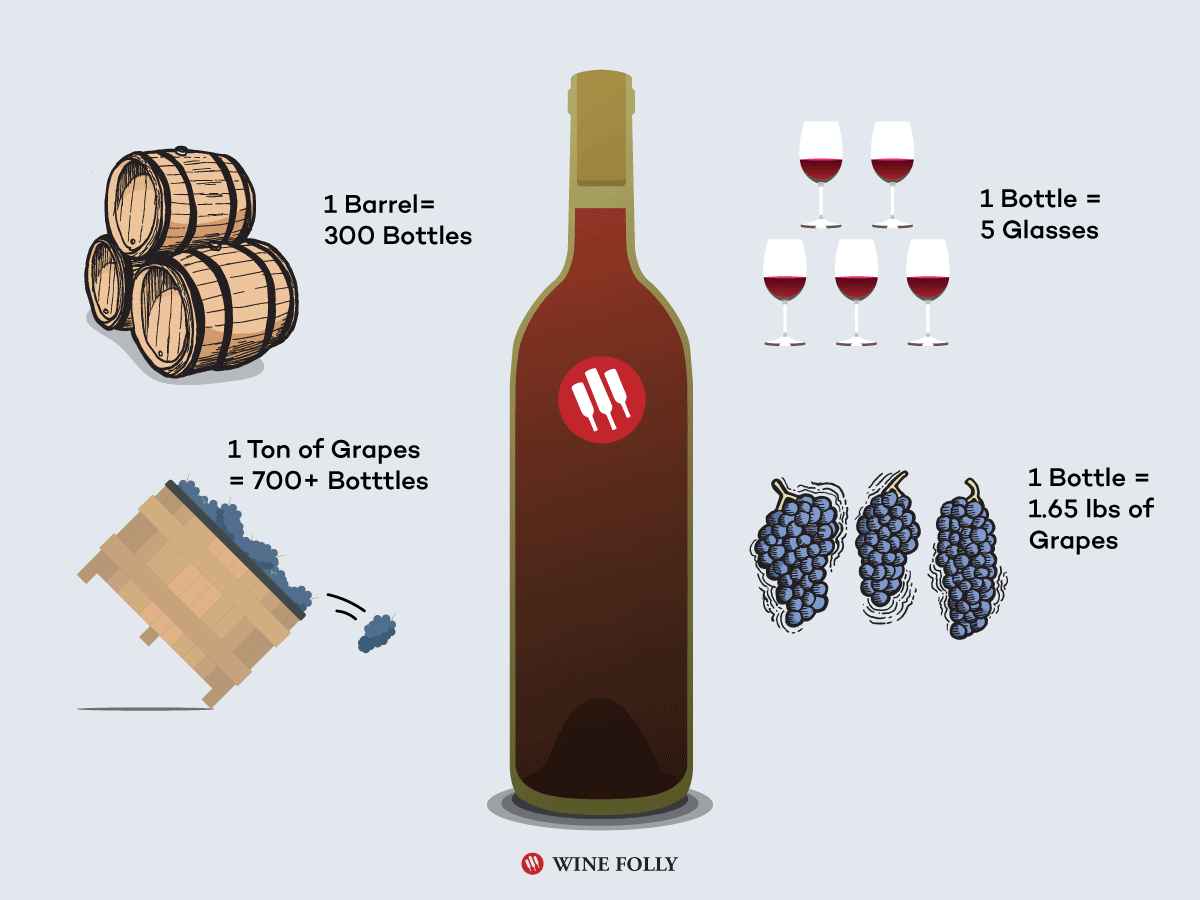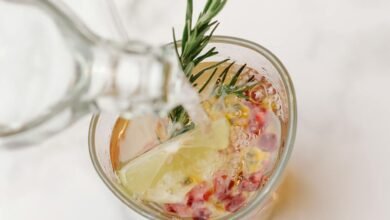How Many Glasses of Wine in a Bottle? Uncork the Facts!

A standard 750ml bottle of wine contains approximately 5 glasses of wine. This can vary depending on the size of the glass and the amount poured per serving.
Knowing how many glasses are in a bottle is helpful when planning for a party or dinner event. It allows for accurate purchasing and serving of the wine. Additionally, it can be useful for tracking the amount of wine consumed for health or budget reasons.
Overall, understanding the number of glasses in a bottle is a basic but important knowledge for wine enthusiasts and casual drinkers alike.
The Standard Wine Bottle
When it comes to understanding how many glasses of wine are in a bottle, it’s essential to start with the standard wine bottle. Knowing the volume breakdown and the common bottle shapes and sizes can provide valuable insights for both wine enthusiasts and casual consumers.
Volume Breakdown
The standard wine bottle typically holds 750 milliliters of wine. This volume equates to approximately 25.4 fluid ounces or 4 to 6 glasses of wine, based on the standard serving size of 5 ounces per glass.
Bottle Shapes And Sizes
Wine bottles come in various shapes and sizes, with the most common being the Bordeaux-style bottle and the Burgundy-style bottle. The Bordeaux bottle is known for its straight sides and high shoulders, while the Burgundy bottle features a wider body and sloping shoulders.
Additionally, there are magnum bottles, which hold twice the volume of a standard bottle, equivalent to 1.5 liters or approximately 10 glasses of wine. Other larger formats, such as jeroboams, methuselahs, and nebuchadnezzars, are also available for those hosting larger gatherings or special occasions.
Glasses To Bottle Ratio
When it comes to the glasses to bottle ratio, a standard wine bottle contains around 5 glasses of wine. This ratio can vary based on glass size and pour volume. Remember to consider serving sizes when estimating glasses per bottle.
Pouring The Perfect Glass
When it comes to pouring the perfect glass of wine, understanding the glasses to bottle ratio is essential. This ratio refers to the number of standard-sized wine glasses you can typically pour from a single bottle. While it may seem straightforward, there are various factors that can affect the serving size.
Variables Affecting Serving Size
Several variables can influence the number of glasses you can pour from a bottle of wine. These variables include:
- The size of the wine glass: The size of the glass will determine how much wine it can hold. While a standard wine glass can hold around 5 ounces (148 ml) of wine, larger glasses can accommodate more.
- The type of wine: Different types of wine have different serving sizes. For example, a bottle of sparkling wine or champagne typically yields more glasses due to smaller serving sizes.
- The pouring technique: The way you pour the wine can also impact the serving size. Pouring slowly and carefully can help maximize the number of glasses you can pour.
- The amount of sediment: If the wine has sediment, you may need to leave some behind when pouring to ensure a clearer glass. This can slightly reduce the number of glasses you can pour.
- The style of wine: Some wines, such as fortified wines or dessert wines, are often served in smaller quantities due to their higher alcohol content or sweeter flavors.
By considering these variables, you can better estimate the glasses to bottle ratio for different wines. It’s important to keep in mind that these ratios are approximate and can vary depending on personal preferences and pouring techniques.
In conclusion, understanding the glasses to bottle ratio is key to ensuring you have an adequate supply of wine for your gathering. By taking into account factors such as glass size, wine type, pouring technique, sediment, and wine style, you can pour the perfect glass and enjoy your favorite wine to the fullest.
Types Of Wine Glasses
When it comes to enjoying a glass of wine, the type of glass you use can greatly enhance the overall experience. Different types of wine glasses are designed to complement specific varietals, allowing you to fully appreciate the flavors and aromas of the wine. In this article, we will explore the three main types of wine glasses: red wine glasses, white wine glasses, and specialty glasses.
Red Wine Glasses
Red wine glasses are characterized by their larger bowl and wider opening. The size and shape of these glasses allow the wine to come into contact with more air, which helps to release the wine’s aromas and enhance its flavors. The broader bowl also allows for better aeration, which can soften the tannins in red wines. The most common red wine glass is the Bordeaux glass, which has a tall, wide bowl, perfect for full-bodied red wines like Cabernet Sauvignon and Merlot. Other red wine glasses include the Burgundy glass, which has a wider bowl for delicate and aromatic reds like Pinot Noir.
White Wine Glasses
White wine glasses, on the other hand, have a smaller bowl and narrower opening compared to red wine glasses. The smaller size helps to preserve the delicate aromas of white wines, keeping them fresh and crisp. The narrower opening also directs the wine to the tip of the tongue, enhancing the perception of acidity. The most common white wine glass is the Chardonnay glass, which has a U-shaped bowl that allows the wine to breathe and develop its flavors. Other white wine glasses include the Sauvignon Blanc glass, which has a smaller bowl for lighter and aromatic white wines.
Specialty Glasses
In addition to red and white wine glasses, there are also specialty glasses designed for specific types of wine. These glasses are tailored to enhance the unique characteristics of particular varietals. For example, Champagne flutes are tall and slender, preserving the bubbles and showcasing the effervescence of sparkling wines. Port wine glasses have a smaller, narrower bowl to concentrate the aromas of fortified wines. Dessert wine glasses are smaller in size and often have a tulip-shaped bowl to capture the concentrated flavors of sweet wines.
Choosing the right wine glass for your preferred varietal can truly elevate your wine-drinking experience. Whether you’re sipping on a rich and bold red or a crisp and refreshing white, using the appropriate glassware will enhance the aromas, flavors, and overall enjoyment of the wine.
:max_bytes(150000):strip_icc()/how-many-glasses-in-bottle-0124-cf64fc3cf99e408a9df3447a23cab9f8.jpg)
Credit: www.marthastewart.com
Pouring Techniques
When it comes to pouring wine, the technique can greatly impact the experience and the number of glasses you can get from a bottle. Mastering the art of pouring and avoiding overpouring can help you get the most out of each bottle of wine.
The Art Of The Pour
Mastering the art of pouring wine involves a delicate balance of control and precision. A smooth and steady pour not only enhances the presentation of the wine but also helps in portion control, ensuring you get the maximum number of servings from a single bottle.
Avoiding Overpouring
Overpouring can lead to a significant reduction in the number of glasses you can pour from a bottle of wine. By exercising caution and control, you can avoid overpouring, ultimately maximizing the number of servings you can enjoy from each bottle.
Wine Tasting Etiquette
Explore wine tasting etiquette to know how many glasses of wine in a bottle. Understanding this can enhance your experience. Remember to pace yourself and savor each pour during the tasting session. It’s all about enjoying the flavors and aromas in moderation.
Wine tasting is not just about sipping and enjoying the flavors; it is an art that involves following certain etiquette. Whether you are a wine enthusiast or attending a formal wine tasting event, knowing the proper wine tasting etiquette can enhance your experience and make you feel more confident. In this section, we will explore some essential aspects of wine tasting etiquette, including sample serving size and the choice between spitting or swallowing.
Sample Serving Size
When it comes to wine tasting, it’s important to understand the appropriate sample serving size. The purpose of a tasting is to evaluate the wine, not to consume it in large quantities. Typically, a sample serving size is about 1 to 2 ounces (30 to 60 milliliters) per wine. This allows you to get a sense of the wine’s aroma, flavor, and texture without overwhelming your senses. It’s worth noting that during a tasting event, multiple wines are usually served, so moderation is key.
Spitting Or Swallowing
One of the dilemmas faced by wine tasters is whether to spit or swallow the wine after tasting it. The decision ultimately depends on your personal preference and the circumstances. In formal wine tastings, spitting is common practice, especially if there are many wines to taste. This helps maintain a clear palate and prevents intoxication. Spitting may seem unusual at first, but it is considered acceptable and professional. However, if you are attending a social gathering or a more relaxed wine tasting, swallowing the wine is perfectly acceptable. Just be mindful of your alcohol intake and pace yourself to avoid overindulgence. Remember, the purpose of wine tasting is to appreciate the flavors and characteristics of the wine, not to get drunk. In conclusion, understanding wine tasting etiquette is essential for a memorable and enjoyable experience. By adhering to proper sample serving sizes and considering whether to spit or swallow, you can fully appreciate the nuances of each wine and engage in the art of wine tasting with confidence and respect.
Credit: www.batchmead.com
Impact Of Alcohol Content
Understanding the impact of alcohol content in wine is crucial for responsible consumption. The amount of alcohol in a wine can vary significantly based on its alcohol by volume (ABV) percentage. This not only affects the overall strength of the wine but also influences how many glasses can be poured from a single bottle.
Alcohol By Volume (abv)
The alcohol by volume (ABV) percentage indicates the proportion of alcohol in a wine relative to the total volume. It typically ranges from 8% to 17%, with most wines falling between 12% and 15% ABV. Wines with higher ABV percentages are stronger and may require smaller serving sizes to moderate alcohol intake.
Adjusting Glass Size To Abv
When serving wine with higher ABV percentages, opting for smaller glass sizes can help control alcohol consumption. This allows for a balanced and enjoyable drinking experience without the risk of overindulgence. Conversely, wines with lower ABV percentages can be served in standard glass sizes without the same level of concern.
Hosting Wine Events
Planning a wine event? Consider the number of glasses in a bottle for your guests.
Calculating For A Crowd
Estimate how many bottles you need based on attendees and servings per bottle.
Offering A Variety
Ensure a mix of red, white, and sparkling wines for diverse preferences.

Credit: winefolly.com
Preserving Leftover Wine
A standard 750 ml bottle of wine contains about 5 glasses of wine. If you have leftover wine, you can preserve it by re-corking the bottle tightly and storing it in a cool, dark place. Alternatively, you can transfer it to a smaller container to minimize air exposure and prolong its shelf life.
Storage Tips
Proper storage ensures wine freshness. Store in a cool, dark place.
Keep the bottle corked or capped. Store wine on its side.
Gadgets For Preservation
Various gadgets help preserve leftover wine. Vacuum sealers are popular.
Wine stoppers and preservers are handy. Use inert gas systems.
Consider investing in a wine fridge for long-term storage.
Preserving Leftover Wine:
Leftover wine? Don’t worry, there are ways to keep it fresh!
Storage Tips
- Store in a cool, dark place.
- Keep the bottle corked or capped.
- Store wine on its side.
Gadgets For Preservation
- Vacuum sealers
- Wine stoppers and preservers
- Inert gas systems
- Consider a wine fridge
Frequently Asked Questions
How Many Glasses Of Wine Are In A Bottle?
On average, a standard bottle of wine contains approximately 5 glasses of wine (based on a standard serving size of 5 ounces per glass).
How Much Wine Do I Need For A Party Of 10?
Assuming each guest will consume 2 glasses of wine, you will need approximately 3 bottles of wine for a party of 10.
What Size Bottle Of Wine Should I Buy For A Dinner Party?
If you’re serving wine with dinner, you should plan on each guest consuming 1-2 glasses of wine. For a party of 6-8 guests, a standard 750 ml bottle of wine should be sufficient.
How Long Does An Opened Bottle Of Wine Last?
Once opened, a bottle of wine can last up to 5-7 days if stored properly in a cool, dark place with a cork or wine stopper to prevent air exposure.
Conclusion
Understanding how many glasses of wine are in a bottle can enhance your drinking experience. By knowing the standard pour size, you can savor each glass. Whether sharing with friends or enjoying a quiet night in, this knowledge adds a touch of sophistication to your wine appreciation.
Cheers to informed sipping!



